



Angela Washko is an artist, writer and facilitator devoted to creating new forums of discussions in spaces most hostile towards feminism. She is a Visiting Assistant Professor at Carnegie Mellon University. Since 2012, Washko has also been facilitating The Council on Gender Sensitivity and Behavioral Awareness in World of Warcraft, her most known project: it’s a series of actions taken within the virtual space of World of Warcraft (“WoW”), an online video game set in a fantasy universe in which people play as orcs, knights and wizards. Her research is focused on the social relations between the gamers, with great attention towards on how these relate with feminism and women, who are becoming more and more numerous between the players of this game. Washko investigates also how design elements of the game influence the relationships of the people who inhabit it; it’s a social study on a community expanding more and more widely, and acts within a limited set of rules designed by video game producers.
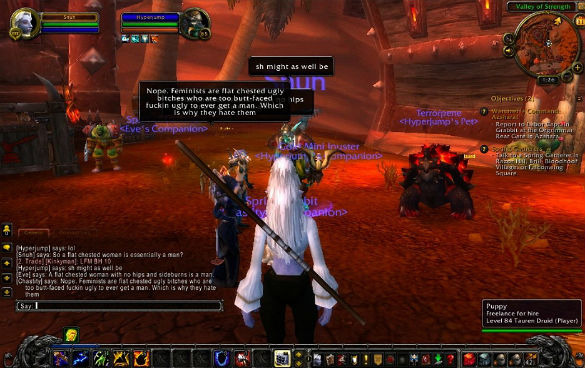
Filippo Lorenzin: I’ve read in some your previous interviews that you started playing WoW in 2006, so we can say you’re a veteran gamer. In the same interviews you pointed out many important elements linking to some of my own research. First of all, the fact you didn’t hesitate to make a parallel between IRL public spaces and online public spaces makes me think you’re part of a generation (as me) that doesn’t care of this division. You create situations and opportunities to let people discuss: it’s as if you meant online gaming as a social activity, rather than a set of rules designed by programmers in which people interact as NPCs (“Non-Player Characters”). What do you think?
Angela Washko: I wouldn’t say that I don’t make a distinction between online and offline space… rather, that these spaces are so integrated and much less separate than the outdated “it’s online/digital therefore it’s not real” model. Online gaming is a very general term and they each have a specific way of operating with contexts that have particular ways of allowing players to communicate to each other. Some of those games are designed to institute high degrees of collaboration in order to get to the most difficult content. World of Warcraft falls into this category. This coercive collaboration breeds a social/chat structure which makes the game as much of a social space as a play space.
My work in WoW is about analyzing the user’s social culture created within the otherwise fantasy oriented landscape and talking to players about the way that it’s developed. So of course there are thousands of things I could have focused on within WoW (and in The World of Warcraft Psychogeographical Association I focus more on exploring the landscape free from quest suggestion/utility and drift about exploring), but for The Council on Gender Sensitivity and Behavioral Awareness in World of Warcraft I was driven to work the way I did due to the treatment of women by the community within the space once players establish their self-identified gender behind the screen. At least on the servers I was playing on.
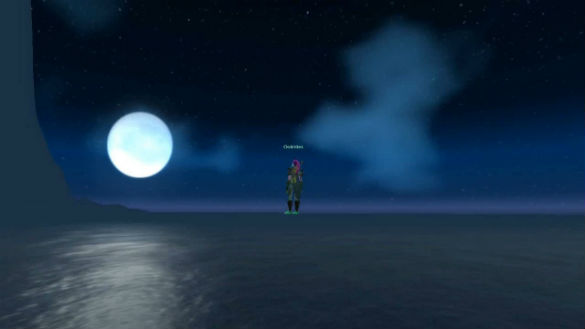
FL: Your use of WoW mechanics in order to raise questions about sexuality and identity makes me think of situationist approaches. As they wanted to create new urbanism refecting the grounded needs and identities of the people, and your actions seem to lead to the creation of a new gaming system, based on players/people who aware of the characteristics of the game and their results in the definition of their identities. Am I wrong?
AW: I guess in WoW I was wondering why the politics of everyday life outside the screen had to govern the rules of this otherwise epic and otherwise not-human-like landscape. I wondered why women were excluded or treated as though they were inherently unskilled (naturally/biologically non-gamers) and at the same time were rewarded for being willing to be abstractly sexualized in guild hierarchies and elsewhere. After being asked to “get back in the kitchen and make [insert player name here] a sandwich” enough times, I stopped playing for a bit. And then I returned, determined to figure out why this was an ubiquitous approach to talking to women in the game space. So I wanted it to be in a place where we could openly discuss and potentially become more considerate about communal language to the point that it could become a much more inclusive space for everyone, and maybe a more diverse social space than we all curate for ourselves in our everyday (physical space) life. Why did our identities outside the screen still have to govern how we are treated as orcs and trolls and whatnot? This game still holds onto a lot of the qualities of the avatar-hidden web 1.0 persona…
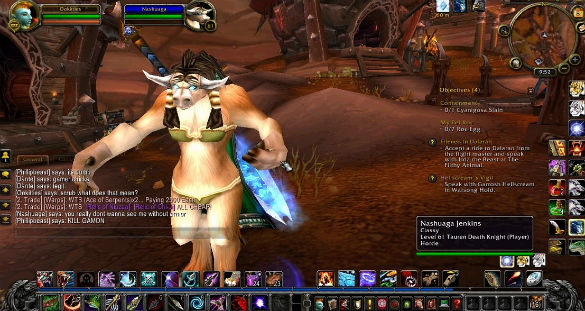
FL: Debord wrote that “the construction of situations begins on the other side of the modern collapse of the idea of the theatre. It is easy to see to what extent the very principle of the theatre – non-intervention – is attached to the alienation of the old world. Inversely, we see how the most valid of revolutionary cultural explorations have sought to break the spectator’s psychological identification with the hero, so as to incite this spectator into activity by provoking his capacities to revolutionize his own life. The situation is thus made to be lived by its constructors.”.
As you can see, it looks like he’s describing your work and I’m really curious to know your opinion.
AW: Well, I have thought about this work (and the psychogeographical work that came slightly later) as definitely linked to Debord and Situationism. I think I became tired of just being able to show the injustices women face everyday. Just prior to the WoW work, I was making videos from replaying single player RPGs from 1992-2003ish showing only women’s storylines and the ways women were represented. I think the work shocked the gallery audiences who saw it because they weren’t gamers and instead of making them think about why the ways in which “women are supposed to act” are embedded in all of our cultural artifacts – it made audiences ask me why anyone would play video games? This frustrated me because I hated the 90s stereotypes that existed about gamers being delinquent and lazy and so I wanted to have conversations in game spaces themselves among the communities that I was involved in rather than just taking from games and then putting them into an art context to be exoticized by art audiences. This is changing a lot as more people identify as gamers and more academics realize the massive amount of people that play games and the cultural importance of games themselves. But I wanted to be able to create a space for discussion with the playerbase itself directly and make that the work rather than making some kind of insightful commentary – to give voice to the community itself to let it speak for itself (regardless of my point of view on the matters discussed) and at the same time try to make sense of how it ended up the way that it did.
FL: The players are being involved in discussions about sexuality and identity. Could you tell your art and cultural references? I can see a lot of ’60s and ’70s approaches…
AW: Oh yes – I mean artists like Valie Export, Adrian Piper, Lynn Hershman, Sophie Calle and the Guerrilla Girls of course, in terms of performance and visibility of women and feminism/feminist activism but in terms of public/media intervention and social practice I think of people like Paper Tiger TV, The Yes Men, The Center for Post Natural History, The Institute for Applied Autonomy, Dara Greenwald, Ant Farm, Kristoffer Orum and Anders Bojen.
I also feel very indebted to remix/appropriation artists like Craig Baldwin who have reclaimed what can be used and how we can rethink existing pop cultural material as sites of intervention for artwork. I also feel like I’m even more influenced by diaristic women writers– particularly Phoebe Gloeckner, Kathleen Blee (sociologist), Elfriede Jelinek, Chris Kraus, Kathy Acker…
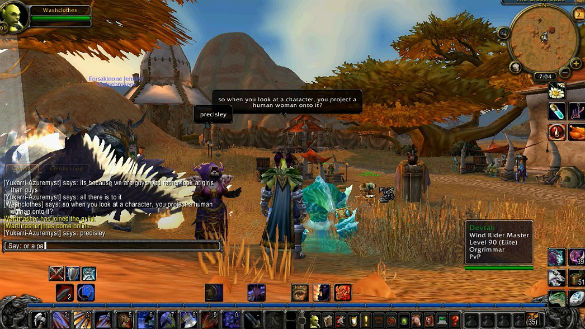
FL: Though question: do you think artists have (or “must have”) a social role? And if they take a stand, what should be their goals?
AW: I think for me interesting artists have a social role! I don’t think that all artists have to make socially engaged work or have to have some kind of service responsibility. I think what was appealing to me about pursuing art as a context for the things I aspire to do is that it is so broad! I mean you have so many “art worlds”, this is a really broad question! So I would say no, but I think artists are in a unique position to have so much flexibility in what you’re permitted to do in your work. In a sociology context, my work would require so much paperwork it would be impossible to get every player I talk to in WoW for my research to sign the necessary papers outside of the game space! So art affords me the flexibility, spontaneity and responsiveness to context to experiment, and really get in there in a way that other fields don’t. So I have found for someone interested in looking at why women are treated the way that they are in fields that are ephemeral and difficult to document, and wanting to have direct discussions about it…art seems to be the field for me to do it in.
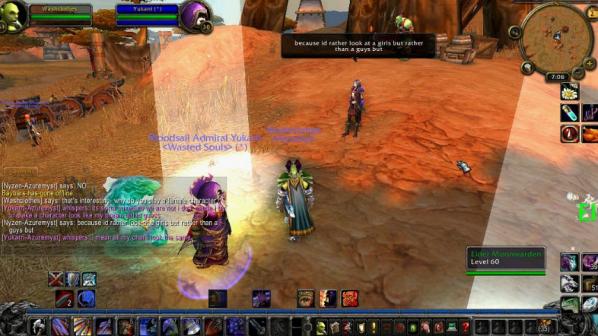
FL: What did you learn from your projects?
AW: Things that I learned which I think will be beneficial for me in the future:
– Be responsible and respectful to everyone you work with.
– Be flexible and responsive. Recalibrate your expectations and be prepared to be wrong about every assumption you’ve already made.
– Think about power. Remember that by being able to capitalize on what you collect, you are in a position of power – make efforts to put yourself in positions of vulnerability. Acknowledge whether or not what you are doing is exploitative. Make everything you do available to all participants who are interested.
– Be clear about what you are doing with the people involved. Be upfront with your participants.
FL: As you previously stated, feminism is a really important element of your research. Did you notice any change between 2010 and now? I’m especially referring to how feminists are portrayed by society, the opportunities in which you can debate and share ideas with somekind of new wave of young artists and critical thinkers who are also deeply involved in these discussions.
AW: When I first started the project, “feminism” was the worst possible word you could say in WoW. Everyone went crazy – feminists were widely described as man-hating whores, flat-chested ugly bitches, women with hairy armpits and worse. But I’ve definitely noticed over time with more mainstream visibility and more writing and a younger generation of artists and celebrities identifying proudly as feminists…the discussions about feminism have become much more complex in WoW and there are many more perspectives and a lot more people self-identifying that way in the space.
Outside of WoW, it seems like more and more women are identifying as feminists and a lot of young writers are really making space for feminism in mainstream media. However, I think it’s been quite polarizing and alienating as well. More and more Men’s Rights Activist groups and nearly militarized manosphere communities are popping up. So with the growth of feminism we also have the growth and visibility of self-identified counter-feminist movements. I think the fact that feminism is a part of mainstream media vocabulary in a way that is a bit more dimensional is definitely positive. The ideas of what a feminist and what a woman can be/do are shifting and evolving and that’s exciting to see.
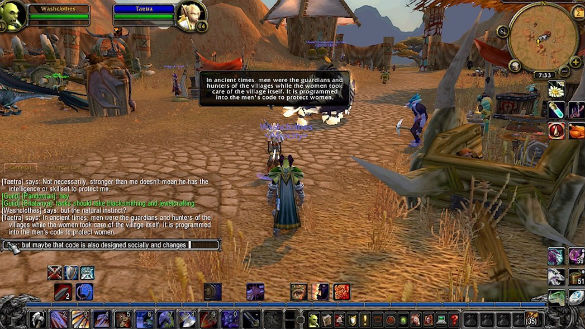
FL: Products like WoW are designed for a masculine audience but looks like it’s not so evident for most of them. With your actions you push other players to discover this aspect, so I wonder if you would define your research as critical art, and or an art that helps others to see the reality behind what the system teaches them).
AW: I would definitely call my work critical art in regard to what you’re proposing! I think in all of my work I am looking at systems and trying to reveal the way they work, using an approach that is accessible to wider audiences than the systems typically reach. I like to approach cultural artifacts by exploring and then dissecting them and then translating/excavating those findings from the site and sharing them as widely as I can.
Featured image: Image from Joel Bakan: The Panopticon Power of the new media. Adbusters Jan 2012.
Marc Garrett and Ruth Catlow interview McKenzie Wark ahead of his keynote speech for Transmediale 2015 in Berlin this year.
It’s ten years since McKenzie Wark published his influential book, A Hacker Manifesto. Divided into 17 chapters, each offers a series of short, numbered paragraphs that mimic the epigrammatic style of Guy Debord’s The Society of the Spectacle. Wark then published, amongst others, a series of critically engaging books such as Gamer Theory and the Spectacle of Disintegration. Ruth Catlow and Marc Garrett from Furtherfield ask Wark how things have changed since these publications, focusing on how our everyday lives have been infiltrated by competitive game-like mechanisms that he described more than a decade ago.
Furtherfield: You published the experimental writing project Gamer Theory first as a book in 2006 and then in 2007 with a specially revised 2.0 version online.
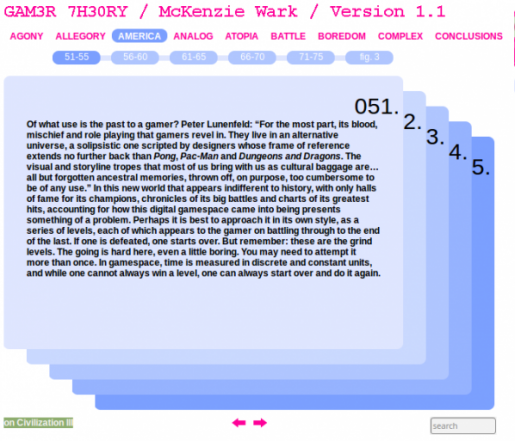
Mckenzie Wark: Yes, although I think the network book version is mostly broken now. Good thing there’s a dead-tree format back-up!
F: In it you argue that we’re living in a world that is increasingly game-like and competitive. Also that computer games develop a utopian version of the world that realizes the principles of the level playing field and reward based on merit; whereas in the world, this is promised, but rarely realized.
MW: Yes, I think one way of thinking about certain games is that they are a fully realized neo-liberal utopia, which actually gives them some critical leverage of everyday life, which is a sort of less-real, only partially realized version of this, where the playing field is not level, where the 1% get to ‘cheat’ and get away with it.
F: You also talk of the “enclosure of the world” within the “gamespace” where the logics of the game are applied as the general patterns of organization in the world. And this happens as we adapt to the allegorical forms of contemporary games media.
How do you think this situation has changed since you wrote Gamer Theory?
MW: Well, to me it looks like the tendency analyzed in Gamer Theory became even more the case. GamerGate looks among other things like a reactive movement among people who really want the neoliberal utopia in all its actual neofascist and misogynist glory to not be exposed as different to everyday life. When women gamers or game journalists stick their hands up and say, “hey, wait a minute”1, they just want to mow them down with their pixelated weapons. So the paradox is that as gamespace becomes more and more ubiquitous, the tension between promise and execution becomes ever more obvious.
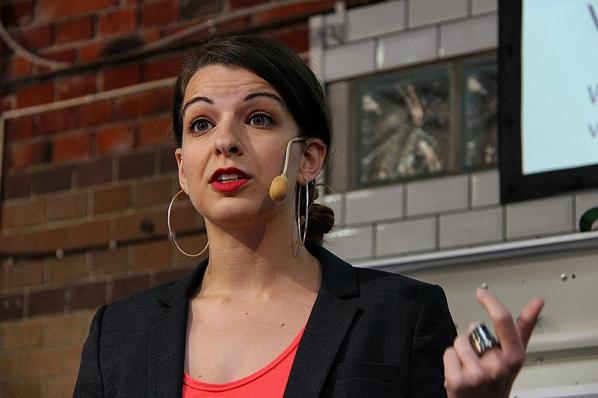

F: Do you see the term Gamification that many theorists use currently as an elaboration of the ideas you developed in Gamer Theory? Or are there significant new ideas being explored?
MW: Ha! Well no, gamification was about celebrating the becoming game-like of everyday life. So I always saw that as a kind of regression from thinking about the phenomena to sort of cheerleading for it.
F: The software developer and software freedom activist Richard Stallman, when visiting Korea in June 2000 illustrated the meaning of the word ‘Hacker’ in a fun way. During a lunch with GNU fans a waitress placed 6 chopsticks in front of him. Of course he knew they were meant for three people but he found it amusing to find another way to use them. Stallman managed to use three in his right hand and then successfully pick up a piece of food placing it into in his mouth. Stallman’s story is a playful illustration of “hack value,” about changing the purpose of something and making it do something different to what it was originally designed to do, or changing the default.2
Stallman was highlighting fun and the mischievous imagination as part of the spirit of what he sees as hack value.
Where do you see lies the hack value in games culture? What has happened to the fun in games? Who’s having it and where is it happening?
MW: Stallman is one of the greats. Sometimes, people have this experience of scientific or technical culture as one of free collaboration, where there’s a real play of rivalry and recognition but based on producing and sharing knowledge as a kind of gift. JD Bernal had that experience in physics in the 30s and Stallman had, I think, a similar experience in computing. I think it’s important for those of us from the arts or humanities to honor that utopian and activist impulse coming out of more technical fields.

There’s a lively, critical and even avant-garde movement in games right now. That’s part of why it has provoked such a fierce reaction from a certain conservative corner. The culture wars are being fought out via games, which is as it should be, as it’s one of the dominant media forms of our times. So there’s certainly some sophisticated fun to be had alongside the more visceral pleasure of clearing levels.
F: “Our species’ whole recorded history has taken place in the geological period called the Holocene – the brief interval stretching back 10,000 years. But our collective actions have brought us into uncharted territory. A growing number of scientists think we’ve entered a new geological epoch.”3 And, this new geological epoch has been proposed as – the Anthropocene.

In your essay ‘Critical Theory After the Anthropocene’4 you say “At a minimum, the Anthropocene calls on critical theory to entirely rethink its received ideas, its habituated traditions, its claims to authority. It needs to look back in its own archive for more useful critical tools.”
What are these ‘useful critical tools’ and how might theorists, new media artists, game designers and society at large put these to work?
MW: The ‘cene’ part of Anthropocene (from the Greek kainos) means a qualitative break in time. If time is in a sense always different, then kainos is the differently-different – a new kind of time. Those like Paul Crutzen who have advocated the use of the term Anthropocene to designate a new geological time have issued a major challenge as to how to interpret such a possibility. I leave it to the scientists to figure out if such a claim is scientifically valid. As someone trained in the humanities, I think the generous, comradely, cooperative thing to do is to try to interpret what our friends and colleagues in the sciences are telling us about the times. So in Molecular Red that was what I set out to do. Let’s take seriously the claim that these times are not ‘like’ other times. That I think calls for a rethinking of what from the cultural past might be useful now. I think we need new ancestors. Which is why, in Molecular Red, I went looking for them, based on the question: to which past comrades would the Anthropocene come as no surprise? I think Alexander Bogdanov, who understood a bit about the biosphere and the carbon cycle, would not be surprised. I think Andrey Platonov, who wrote about the attempts and failures to build a new kind of infrastructure for the Soviet experiment in a new mode of production would not be surprised. There are others, but those I thought were particularly helpful, not least because their Marxism remained in dialog with the sciences and technical arts. I don’t think the more romantic anti-science side of Western Marxism and continental thought is all that helpful at the moment, not least because it rules out of court exactly the kinds of scientific knowledges through which we know about the Anthropocene in the first place. The anti-science critique has been captured by the right, so we need new tactics.
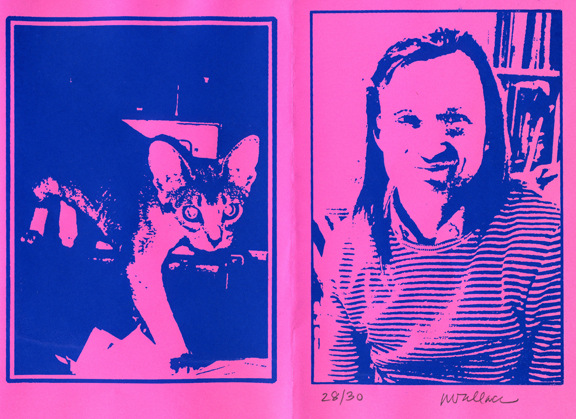
F: Who’d be empowered by an encounter with your ideas and where do you see the potential for agency in the current economic and environmental contexts?
MW: Not for me to say really. Writers are usually the last people to have any clues as to what their writing says. There’s a sort of idiot quality to banging away on a keyboard. We’re word processors. Its always surprising to me the range of people who find something in what I write.
My hunch is that the future is in the hands of an alliance between those who make the forms and those who make the content: a hacker and worker alliance. It is clear that this civilization has already become unreal. Everyone knows it. We have to experiment now with what new forms might be.
F: And, where in the world do you see examples of individuals, groups and organizations, and or companies – who are putting into action some of the critical questions that you’re exploring in your writing?
MW: Besides Furtherfield? I never like to give examples. Everyone should be their own example. To détourn an old slogan of the 60s: be impossible, do the realistic!
F: In your later essay ‘The Drone of Minerva’5 you continue to write about the Anthropocene. But, you also bring to the table the subject of the Proletkult.6 The Proletkult aspired to radically modify existing artistic forms of revolutionary working class aesthetic which drew its inspiration from the construction of modern industrial society in Russia. At its peak in 1920, Proletkult had 84,000 members actively enrolled in about 300 local studios, clubs, and factory groups, with an additional 500,000 members participating in its activities on a more casual basis.
You are writing about the Proletkult in your latest book. Could you tell us a little something about this and how it will connect to contemporary lives?
MW: Proletkult was influential in Britain too, during the syndicalist phase of the British labor movement, up until the defeat of the 1926 general strike. After that the dominant forms were, on the one hand, the ethical-socialism and parliamentary path of the Labour Party, or the revolutionary Leninist party. Well, those paths have been defeated now too. I think we have to look at all of the past successes and failures all over again and cobble together new organizational and cultural forms, including a 21st century Proletkult.7 What that might mean is trying to self-organize in a comradely way to try and gain some collective charge of our everyday lives. It does not mean just celebrating actually existing working class cultures. Rather it’s more about starting there and developing culture and organization not as something reactive and marginalized but as something with organizational consistency and breadth. Since the ruling class clearly doesn’t give a fuck about us, let’s take charge of our own lives – together.
Thank you McKenzie Wark – Ruth Catlow & Marc Garrett 😉
Ruth Catlow will be at Transmediale 2015 CAPTURE ALL, moderating the keynote Capture All_Play with McKenzie Wark, on Sat, 31 Jan at 18:00.
Ruth is also participating in two other events, Play as a Commons: Practical Utopias & P2P Futures and The Post-Digital Review: Cultural Commons – http://www.transmediale.de/content/ruth-catlow
2 March: 1812 Crossing of the Berezina scenario for Richard Borg, Commands & Colors Napoleonics.
6 April: Mac Gerdts, Imperial 2030
4 May: Bruce Quarrie and Russell King, Apokalypse 1945
1 June: Ty Bomba and Joseph Miranda, Russian Civil War 1918-1922
13 July: Greg Costikyan, Pax Britannica. CANCELLED
3 August: H.G. Wells, Little Wars.
“Political theories are only made to die in the war of time. Like military units, they must be sent into battle at the right moment; and whatever their merits or insufficiencies, they can only be used if they’re at hand when they’re needed.” – Guy Debord.
Clausewitz v. Jomini at the Ludic Science Club. 1812 Crossing of the Berezina scenario for Richard Borg, Commands & Colors Napoleonics.
The first of 5 monthly board game ‘Ludic Science Club Sunday Sessions’ organised by Class Wargames at the Furtherfield Commons. This Sunday join writer and academic Dr Richard Barbrook with Class Wargame collaborators for the 1812 Crossing of the Berezina scenario for Richard Borg, Commands & Colors Napoleonics. All Welcome.

Dr Richard Barbrook is the author of Imaginary Futures: From Thinking Machines to the Global Village. In 2008 it won the Marshall McLuhan Award for Outstanding Book of the Year in the Field of Media Ecology. He is a founding member of Class Wargames and co-wrote the script to the group’s film: Ilze Black (director), Class Wargames Presents Guy Debord’s The Game of War.
6th April: Mac Gerdts, Imperial 2030.
4th May: Bruce Quarrie and Russell King, Apokalypse 1945.
6th July: Greg Costikyan, Pax Britannica.
3rd August: H.G. Wells, Little Wars.
All sessions begin at 2.00pm.
To book sessions please contact: ale AT furtherfield DOT org
Furtherfield Commons,
Finsbury Park,
London N4 2PF
To Visit view link – http://www.furtherfield.org/gallery/visit
Featured image: Reason #732 to Learn How to Speak French: The Guy Debord Cineaste streams
McKenzie Wark, author of The Beach Beneath the Street, will give a talk at Furtherfield Gallery about his latest book The Spectacle of Disintegration – Situationist Passages Out of the 20th Century.
Writer and academic Dr Richard Barbrook will give a short introduction to Wark’s work and to Situationism and its relevance to contemporary culture.
BOOK A PLACE
This event has limited availability, to book a place please contact: ale AT furtherfield DOT org
Over fifty years after the Situationist International (SI) first appeared, the group’s restlessly creative experiments in the practice of life – of living, playing and working together – continues to influence activists, artists and writers. From hacker culture and Anonymous, to versions of pyschogeography in the popular writings of Iain Sinclair and Will Self, traces of the whole spectrum of Situationist ideas and practices can be found throughout culture today.
Following his acclaimed history of the SI, The Beach Beneath the Street, McKenzie Wark continues the story after the failures of May 1968. Charting its post-sixties legacy and putting the late work of the Situationists in a broader, deeper context, Wark locates their contemporary relevance, as digital culture opens up new possibilities of experience and new terrains of struggle.
The Spectacle of Disintegration takes the reader through Guy Debord’s late films and his surprising work as a game designer, the political aesthetics of former Situationist T.J. Clark, the Fourierist utopia of Raoul Vaneigem, René Viénet’s earthy situationist cinema, Gianfranco Sanguinetti’s pranking of the Italian ruling class, and Alice Becker-Ho’s account of the anonymous language of the Romany.
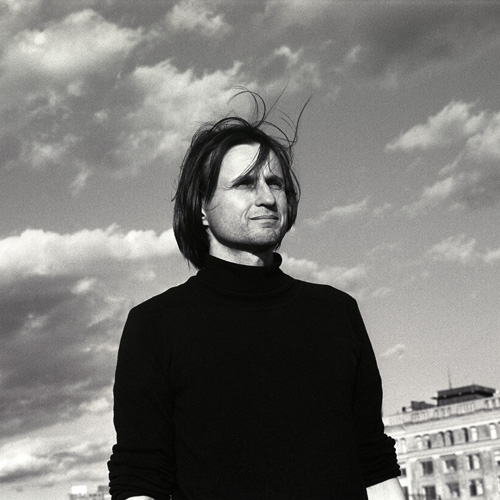
Wark builds on their work to map the historical stages of the society of the spectacle, from the diffuse, to the integrated, to what he calls the “disintegrating spectacle.” At once an extraordinary counter history of radical praxis and a call to action in the age of financial crisis and the resurgence of the streets, The Spectacle of Disintegration recalls the hidden journeys taken in the attempt to leave the twentieth century and plots an exit to the twenty-first.
The Beach Beneath the Street re-presented the Situationist project in response to the demands of our time, to discover the lost entry-points to the routes of play, adventure and resistance in contemporary experiences of communication, architecture, and everyday life. Writing against the boredom induced by the ossified remains of the twentieth-century encounter with art and politics, Wark declares that whilst the Situationists failed to escape the world of spectacle, there might still be hope for us…
More info on Wark’s publication at Verso Books
http://www.versobooks.com/books/1162-the-spectacle-of-disintegration
McKenzie Wark is the author of A Hacker Manifesto, Gamer Theory, 50 Years of Recuperation of the Situationist International and The Beach Beneath the Street, among other books. He teaches at the New School for Social Research and Eugene Lang College in New York City.
Dr Richard Barbrook is the author of Imaginary Futures: From Thinking Machines to the Global Village. In 2008 it won the Marshall McLuhan Award for Outstanding Book of the Year in the Field of Media Ecology [1]. He is a founding member of Class Wargames and co-wrote the script to the group’s film: Ilze Black (director), Class Wargames Presents Guy Debord’s The Game of War [2].
Marc Garrett interviews John Jordan and Gavin Grindon about their collaborative publication, A Users Guide to (Demanding) the Impossible.
Published by Minor Compositions
“This guide is not a road map or instruction manual. It’s a match struck in the dark, a homemade multi-tool to help you carve out your own path through the ruins of the present, warmed by the stories and strategies of those who took Bertolt Brecht’s words to heart: “Art is not a mirror held up to reality, but a hammer with which to shape it.”
Marc Garrett: In the introduction of your publication it says that it, “was written in a whirlwind of three days in December 2010, between the first and second days of action by UK students against the government cuts, and intended to reflect on the possibility of new creative forms of action in the current movements. It was distributed initially at the Long Weekend, an event in London to bring artists and activists together to plan and plot actions for the following days, including the teach-in disruption of the Turner Prize at Tate Britain, the collective manifesto write-in at the National Gallery and the UK’s version of the book bloc.”
I think readers would be interested to know how the ‘teach-in disruption’ and the ‘collective manifesto write-ins’ went?
John Jordan: I was not at the first Turner teach-in so can’t give first hand account. From what I’ve heard it was a wonderful moment where the sound of the action penetrated into the room where the Turner Prize were being held, as the back drop of the channel 4 live link up. Kind of perfect, because it was a sound artist who got the award.
As for the National Gallery event – this was held during the evening after one of the big days of student action. Having spent the day being trampled on by her majesties police horses, a load of us went up to the National Gallery and mingled in front of Manet’s Execution of Emperor Maximillian, opposite a corridor that held a Courbet painting. It was a perfect placement as Courbet of all the 19th artists was really the one who understood the role of art within an insurrection, putting down his paintbrushes to apply his creativity directly to the organising of the Paris Commune of 1871 just as the impressionists fled the city to the quiet of the countryside. Only to return a few years later when Impressionism was launched, as a kind or artistic white wash over the massacres of the Commune, a return to normal bourgeois representation. Courbet had used the rebel city, a “paradise without police” as he put it, as a canvas to create new forms of social relationships and new ways of public celebration, including the destruction of the monument to Empire and Hierarchy, the Vendome column.
Several hundred artists and art students at a given moment sat down and occupied room 43, telling the staff that we would leave once a collective manifesto had been written. Which is what happened. Small groups of 10 or so were formed as the guards and director of the gallery paced up and down unsure of how to react, each group worked on points for the manifesto which were then read out and merged in ‘The Nomadic Hive Manifesto’ – http://www.criticallegalthinking.com/?p=998 – it was an extraordinary moment of collective, emergent intelligence, a reclaiming of a public cultural space from the realm of musefication and representation.
MG: ‘A Users Guide to (Demanding) the Impossible’ features quotes by individuals and groups, who have inspired many of us in the networked, Furtherfield community. But, I am also aware that you may be part of a younger generation, presently experiencing the brunt of education cuts imposed by the current government coalition. Could you explain how these cuts are effecting you and your peers?
JJ: Well I wish I was a younger generation !!! I’m 46 years old, it was written for the youth !! You should talk to some arts against cuts folk, I can put you in touch if you need to?
Gavin Grindon: I’m not exactly ‘the younger generation’ either, but I guess I’m in a strange position between. I recently finished my PhD, so a lot of my friends are either students or just becoming teachers. There aren’t many jobs about, academic or otherwise, and most of them are doing multiple part-time, short-term jobs to make ends meet, without the assumed security or career progression of a generation before, and the cuts are only going to exacerbate that situation. I guess what’s new is a recession on top of these kind of precarious work conditions, which extend far beyond the University. With part-time, hourly-paid and non fixed positions, replacing real jobs.
Of course it’s damaging, but it’s also been inspiring to see students responding to turning over lessons to discuss the cuts and seeing them on the streets. It’s politicised a lot of young people, and there’s an opportunity there. At one of the University’s I work at, it was great to see the art students working together to make protest banners, not in their studios but in the foyer, where other people could see and join in. And when I started talking with them, we began to realise that with all the technical resources of an art school at their disposal, it was possible to be much more ambitious and imaginative than just making banners or placards, the standard objects of protest. But the history of a lot of art-activist groups who had these kind of ambitions isn’t taught, never mind the more popular history of the arts of social movements itself. And it’s not just about knowing and being inspired by some great utopian tales of adventure, or understanding yourself as part of a historical legacy – it leaves you strategically disadvantaged about what can be done. So starting a conversation with these students, was, as JJ says, kind of the idea behind the guide.
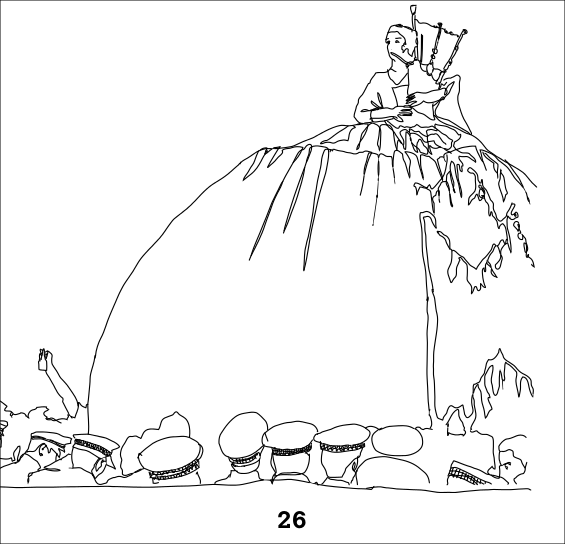
MG: There are various other creative protest groups such as UK Uncut (http://www.ukuncut.org.uk/) and the University for Strategic Optimism (http://universityforstrategicoptimism.wordpress.com/), whom I interviewed live on Resonance FM, December last year (http://www.furtherfield.org/radio/8122010-university-strategic-optimism-and-genetic-moo). Are you connected to any of these creative activist groups, and are there any others in the UK you would like us to be more aware of?
JJ: Yes – I’ve worked with UK Uncut, and was unfortunately arrested in Fortnum and Mason, whilst recording the BBC 4 afternoon play, but that’s another story! There are lots of interesting groups that work on the edge of art and activism, right now a space to keep an eye out for and to visit is THE HAIRCUT BEFORE THE PARTY – http://www.thehaircutbeforetheparty.net/ – set up by two radical young art activists who have opened a hair dressers that offers free hair cuts and political discussion about organising and friendship, rebellion and the material needs to engage in it. The salon is in 26 Toynbee Street, near Petticoat Lane and open till November. It’s an interesting example of a medium to long term, art activist project that attempts to create new forms of relationship and affinity, and sees itself as building radical movement and not simply representing them.
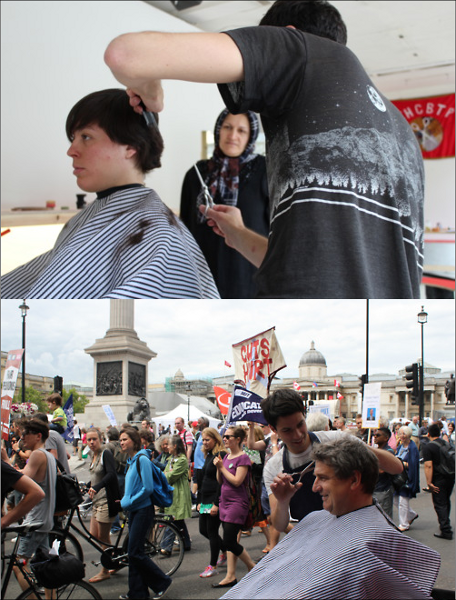
GG: Yeah, again the idea of the text was to build on the connections that are already there, which THBTP does too in a more informal, social way. And for sure, you shouldn’t be seen at the June 30th strikes or UK Uncut’s support actions without a flash new haircut. I should also get a plug in for Catalyst Radio – http://www.catalystradio.org/ a new 24/7 DIY UK-wide activist radio station, which started up the other week and is still growing, and brings together a lot of radical radio projects from around the country.
MG: Do you share a mutual empathy and respect for other protesters elsewhere such as those in Spain and in Greece, and in the Middle East?
JJ: Of course. Although it feels like the camp protests are lacking a conflictual approach and without the mixture of conflict and creativity, protest can easily be ignored, which is a bit what has happened with all the European camps. Although sitting here in the British library its easy to be critical ! Whatever happens, those involved in the camps will have tasted politics, new friendships, alternative ways of organising etc… As for the middle east, its all still in flux, who knows what will happen and the role of artists and musicians has been pretty key in setting the powder kegg alight there..
GG: Yeah, though I think there’s a tension between the symbolic solidarity of occupying city squares and the strategic differences between activist practices in different countries. I think solidarity between these struggles is massively important, though I’m personally not sure how it’s best to manifest that here right now.
MG: In the User’s guide, it mentions the workshops in art and activism at the Tate Modern, held by the Laboratory of Insurrectionary Imagination (Labofii), entitled it ‘Disobedience makes history’. And that Laboffii “was told, in an email, by the curators that no interventions could be made against the museum’s sponsors (which happen to be British Petroleum) [..] decided to use the email as the material for the workshop. Projecting it onto the wall they asked the participants whether the workshop should obey or disobey the curator’s orders.”
What I find interesting regarding this episode is both that a big institution would take the risk of inviting in art and activist culture to their usually, protected environment whilst being sponsored by British Petroleum; and the different forms of controversies reaching the public from such situations. I am surprised that Laboffii would even consider doing such a project in the Tate Modern in the first place, but also pleased, because of the dialogue that has come out of the clash of different political contexts. So, isn’t it the case that we need to explore issues of corporate corruption further within these big institutions so that those who would not usually consider such things are suddenly faced with the issues?
GG: I’m sure JJ has plenty to say about this. But more generally, it depends *how* they function as a platform. An art gallery or a university can be a great discursive space to explore issues, but the bounds of that debate are also strictly limited in lots of ways. This is a problem with the idea of a bourgeois public sphere. Most often, that boundary is that you can debate whatever you like but questioning the basic systemic assumptions on which such spaces rest isn’t possible, at least not in a practical way. The lab’s workshop at the Tate tried to question exactly that kind of assumption about what culture is for, and who it benefits. But for many activists from social movements, who have less faith in the public sphere and its institutions to resolve issues by discussion, that neutered debate is more of a problem than a benevolent gift to the public, and they have to take a different approach. Its not necessarily opposed to those institutions as a whole, but just asks them to make good on what they claim to be.
JJ: It’s a long story, but the key is to be able to put one foot inside these institutions and to be not frightened to KICK. But not to KICK symbolically, to really kick, to really shake them up and to be able to let go of one’s cultural capital. The Labofii will NEVER be re-invited to do anything at the TATE, bang goes all our chances of a retrospective in the fashionable art activism world !!! 😉 But, what we gain is that we were free ! When the curators told us that we could not do anything, could not take action against BP and we refused to obey them, we were free, we could do what we wanted because they could not give us anything in return. The Zapatistas say, “we are already dead so we are free” – when power can give you nothing you want, you can do anything.. this is a very powerful moment. To see the faces of the curators, the head of public, the head of security etc during the meeting where they tried to censor the lab, was priceless – they had always had power over artists, because artists will normally do ANYTHING to get their work in the Tate, but we did not care, we cared about the politics, about the actions, about climate change and social injustice – we were more powerful than the institution in that moment because we were no longer dependent on them.. it was one of the most beautiful moments… and now the movement against oil sponsorship is spreading everywhere. The message is simple, give up your cultural capital throw away your dependence on these institutions and be free…
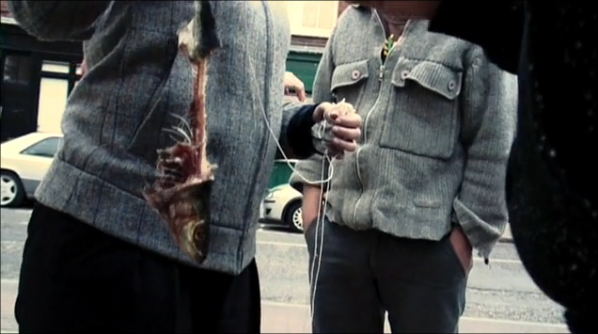
MG: I come from a background of hacking, social hacking and D.I.Y culture, and instead of going to University I chose to be self-educated, creating alternative groups for self discovery and art with dedication to social change. And even though, many are fighting the education cuts right now, what are your own ideas around self-education, do students really need to go to college now that there are so many different forms of information and ways in creating one’s own place in the world ‘with others’?
GG: A lot of experiments with autonomous self-education have sprung up recently which ask just this question, like the Really Free School (http://reallyfreeschool.org/), there are even some more institutional business-model experiments online with peer-to-peer education. But at the same time the catchment of both of these is relatively narrow at the moment, so I think there’s still a place for these kind of education institutions, and there are interesting radical experiments going on all over, either by individuals or whole departments, although the cuts to institutional funding for education by the government changes the playing field again, so there’s an opportunity for something like this to become less marginal, both inside and outside the university.
MG: JJ, In 2005 you wrote, Notes Whilst Walking on “How to Break the Heart of Empire”, in it you write “Radicals are often vulnerable souls. Most of us become politically active because we felt something profoundly such as injustice or ecological devastation. It is this emotion that triggers a change in our behaviour and gets us politicised. It is our ability to transform our feelings about the world into actions that propels us to radical struggle. But what seems to often happen, is that the more we learn about the issues that concern us, the more images of war we see, the more we experience climate chaos, poverty and the every day violence of capitalism, the more we seem to have to harden ourselves from feeling too much, because although feeling can lead to action we also know that feeling too much can lead to depression and paralysis…” How the hell do you remain positive when you know how many horrible and disgusting things are being done to decent folks and the planet all of the time?
JJ: Unfortunately there are no magic recipes that can protect us from such feelings, a lot depends on context on our particular situations etc. But here are a few tips that have helped me keep the despair of capitalism at bay:
1) Resist the spell of individualism that capitalism tries to weave around us, a spell that chains us to the fantasy of autonomy and keep us in a state of sadness and paralysis. Break this spell and its toxic chains by realising that you are part of a greater whole, that working with others gives us strength, that seven minutes making real friendships (face to face) is more political than seven days glued to a computer browsing social networks in a trance, that inevitably fails to shake the loneliness of modern life.
2) Build a gang, a group, a collective, a crew – remember the joy of plotting things together, the power and possibilities when work and imagination is shared. In fact, imagination finds it’s insurrectionary potential when we share it, when it’s freed from the privatised ego, escapes from shackles of copyright and the prison’s of the art world.
3) Learn the skills to work together with others, consensus decision making, group facilitation, conflict resolution etc. We need to re learn collective working methods, capitalism has destroyed all our tools of conviviality and we need to reclaim them back, recreate new forms of being together.
4) Redefine Hope. Not as something that will come and save us, like a saviour, but as something that comes from not knowing what will happen next, something that takes place when we act in the immediate moment and don’t know what will happen and trust that history is made from acts of disobedience that did not necessarily have any idea of what the next step was…
5) Remember that victory is not always what happens, but what did not happen. Social movements tend to forget this. Look at all the nuclear power stations that WERE not built, all the wars that did not happen, the laws that were never passed, the free trade agreements that were never agreed on, the repressions that the state could not get away with, the gmo’s that were never planted. One of my favourite books, what I call prozac on paper, is Rebecca Solnit’s HOPE IN THE DARK (http://www.goodreads.com/book/show/28048.Hope_in_the_Dark) – it’s a lovely little book which redefines hope in the most beautifully optimistic way, recommended reading when capitalism seems irresistible.
6) When everything appears useless, try to change your conception of time… think deep time, not shallow modern now time, but think about the generations that went before you and those that will come after you. Try to imagine what the generations of the future will think about your actions, imagine those from the past that fought for the emancipation of slaves and yet never saw the results of their actions, those who died for the eight hour day, for the right to build a union, the right to vote or publish an independent magazine. Spend time imagining how those alive in 50, 100 years will view your life and work…

MG: In the publication, you mention Marx and Debord. “We can all be engineers of the imagination”…”that our “general intellect”, all the collective knowledge and skills we use in making things, are taken away from us and embodied instead in the machines of our work. What would happen if we somehow re-engineered these machines if we did what Guy Debord argued and started, “producing ourselves… not the things that enslave us.” Do you see the recent cuts across the board as an example of how the powers that be are actively dis-empowering the working classes?
GG: Definitely. The cuts aren’t just about an experience of ‘austerity,’ however long term, but constitute a historical attack on poor and working people. They’re an attempt to technically recompose the material of the institutions, structures, ideas and habits people live through, in order to limit their ability to resist and remake them for themselves. In factory production, that involved the local restructuring of machine-labour, but later at a wider level Keynesian economic restructuring. This neoliberal restructuring of education is an extension of capitalist discipline into a new area, an attack on a social space which has historically been a base for social change. The government has made this pretty clear by, for example, David Willetts’s dictate amidst these massive cuts, to the Arts and Humanities Research Council, that the Tory party’s vacuous advertising slogan “the big society” become a core research area, replacing the less ideologically narrow area of ‘communities and civic values’; and the Department for Business and Innovation’s concomitant rewriting of the 1918 Haldane principle, that research directions are best decided by researchers through peer review.
The optimistic take on this is not that it’s an inevitable recuperation of resistance, which was the position Debord tended towards in the end, but that capital is always on the back foot – that its own developments are driven by and a response to social movements. That it’s an open dialectic (or if you prefer, not a dialectic at all). There’s a kind of neurosis to it, although rather than excluding the other to maintain its ego, the state is including everything to stave off other possibilities – you can see this in the language. The whole discourse of ‘participation’ and networks in business (and since the 1990s, also in art), is as Boltanski and Chiapello observed in their book the New Spirit of Capitalism, a recuperation of the language and terms of 1960s social movements – movements which first properly gave birth on a mass scale to the kinds of self-consciously autonomous and creative politics, or art-activism, which we talk about in the guide. Likewise, the big society is focused on mutuality, and there’s a strange recuperation of libertarian and radical thought by the thinkers behind it like Phillip Blonde. In this case, you’re left with a stunted vision of the anarchist idea of mutual aid, without any institutional aid, and structurally limited mutuality. But rather than simply critique this, I’m interested to look at how we might otherwise structurally and materially embody other kinds of social relation. Obviously this starts on a much smaller scale, and is often more directly materially embodied. University departments’ attempts to support radical philosophy within existing institutions and setting up new autonomous radical art institutions are two possible, but not mutually exclusive, directions here. As, of course, at the most local, accessible level, are the art-activist practices and objects we discuss in the guide.
Our new book-film is out “Les Sentiers de L’utopie”
Free online (in french) : http://www.editions-zones.fr/
Our blog: http://lessentiersdelutopie.wordpress.com/
our twitter: @nowtopia
3 different links to download the publication:
http://www.minorcompositions.info/usersguide.html
http://artsagainstcuts.wordpress.com/2010/12/06/a-users-guide-to-demanding-the-impossible
http://www.brokencitylab.org/notes/required-reading-a-users-guide-to-demanding-the-impossible
The Font used was Calvert is by Margaret Calvert, designer of our road signs.
Words: Gavin Grindon & John Jordan Design: FLF Illustration: Richard Houguez Original Cover: The Drawing Shed Produced by the Laboratory of Insurrectionary Imagination, London, December 2010. www.labofii.net Anti-copyright, share and disseminate freely.
More about Minor Compositions – a series of interventions & provocations drawing from autonomous politics, avant-garde aesthetics, and the revolutions of everyday life.
http://www.minorcompositions.info/
Crude awakening: BP and the Tate. The Tate is under fire for taking BP sponsorship money. Does corporate cash damage the arts — or is it a necessary compromise? We asked leading cultural figures their view. Interviews by Emine Saner and Homa Khaleeli. guardian.co.uk, Wednesday 30 June 2010. http://www.guardian.co.uk/artanddesign/2010/jun/30/bp-tate-protests
by Class Wargames
Saturday 26th September 2009 12-5pm:
Participatory demonstration – Marcel Duchamp meets Blue Peter
Sunday 27th September 2009 12-5pm:
World Premier of Class Wargames film – The Game of War
The Situationist Raoul Vaneigem famously wrote “There are no more artists since we’ve all become artists. Our next work of art is the construction of a full-blooded life.” – The Revolution of Everyday Life.
Debord, strategist of the Situationist International, developed the game while in exile after the May ’68 Revolution, and came to regard it as his most important project. For Debord, The Game of War wasn’t just a game – come and learn how to fight and win against the oppressors of the spectacular society! Join the Class Wargames crew, Richard Barbrook, Fabian Tompsett, Ilze Black and others, in redefining political and contextual territories.
On Saturday the 26th, Class Wargames presents ‘Marcel Duchamp meets Blue Peter’, a day of making and playing Guy Debord’s The Game of War.
Sunday is the World Premier launch of the Class Wargames’ film – The Game of War. Directed by Ilze Black; script writers Richard Barbrook and Fabian Tompsett; xenography by Alex Veness, voice over by Hayley Newman and Alex Veness.
For more information about Class Wargames and players:
http://www.classwargames.net
Marcel Duchamp meets Blue Peter.
Day 1 – 12-5pm Saturday 26th September.
12.00 meet and greet
12.15 introduction by Class Wargames
12.30 building your own game, learning to play and participatory game playing
Film Launch of The Game of War by Class Wargames
Day 2 – 12-5pm Sunday 27th September.
12.00 meet and greet
12.15 View games exhibition and film
14.30 Talk by Class Wargames
15.00 Film launch & drinks
To take part in the game please RSVP to ale[AT]furtherfield[DOT]org
HTTP Gallery
Unit A2, Arena Design Centre
71 Ashfield Road
London N4 1NY
+44(0)79 8129 2734
Click here for map and location details
With thanks to the Arts Council of England for their support.